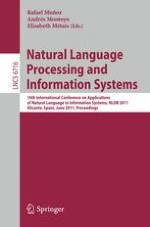This book constitutes the refereed proceedings of the 16th International Conference on Applications of Natural Language to Information Systems, held in Alicante, Spain, in June 2011. The 11 revised full papers and 11 revised short papers presented together with 23 poster papers, 1 invited talk and 6 papers of the NLDB 2011 doctoral symposium were carefully reviewed and selected from 74 submissions. The papers address all aspects of Natural Language Processing related areas and present current research on topics such as natural language in conceptual modeling, NL interfaces for data base querying/retrieval, NL-based integration of systems, large-scale online linguistic resources, applications of computational linguistics in information systems, management of textual databases NL on data warehouses and data mining, NLP applications, as well as NL and ubiquitous computing.
